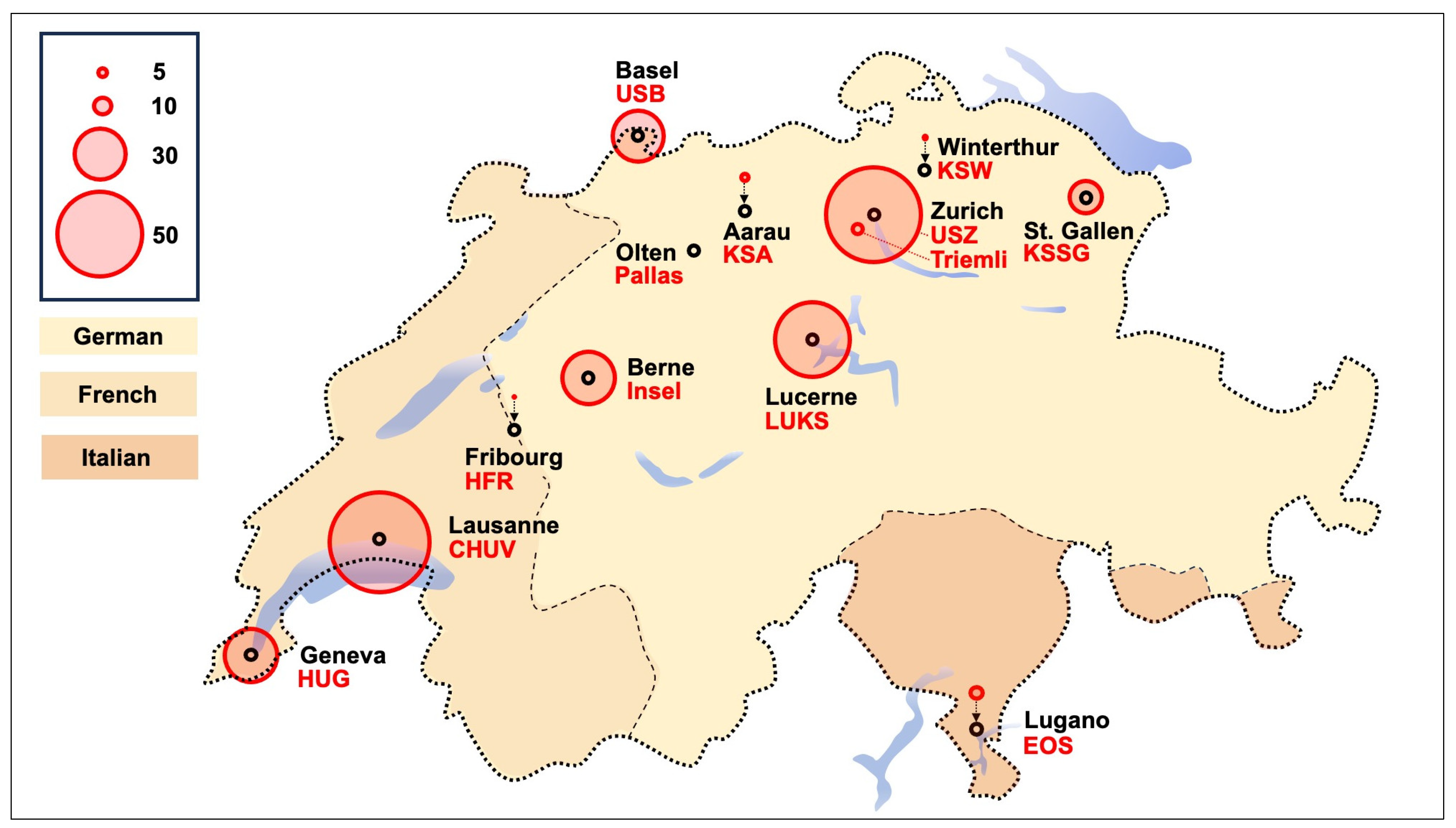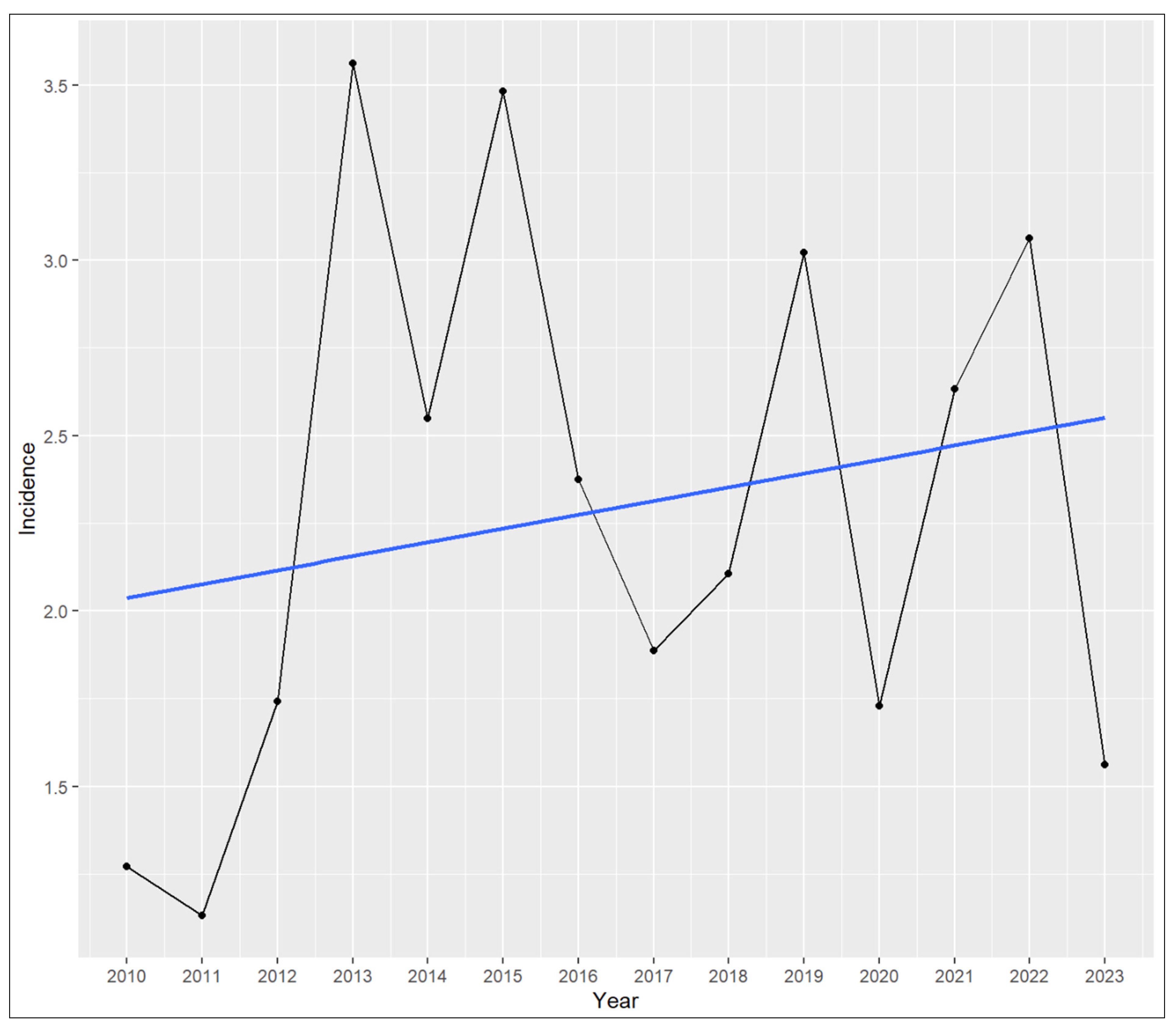Incidence of Acanthamoeba Keratitis in Switzerland
Abstract
1. Introduction
2. Materials and Methods
2.1. Data Collection
2.2. Acanthamoeba Detection
2.3. Statistical Analyses
3. Results
4. Discussion
5. Conclusions
Author Contributions
Funding
Institutional Review Board Statement
Informed Consent Statement
Data Availability Statement
Acknowledgments
Conflicts of Interest
Abbreviations
| AK | Acanthamoeba keratitis |
| PCR | Polymerase chain reaction |
References
- Berrilli, F.; Montalbano Di Filippo, M.; Guadano-Procesi, I.; Ciavurro, M.; Di Cave, D. Acanthamoeba Sequence Types and Allelic Variations in Isolates from Clinical and Different Environmental Sources in Italy. Microorganisms 2024, 12, 544. [Google Scholar] [CrossRef] [PubMed]
- Lorenzo-Morales, J.; Khan, N.A.; Walochnik, J. An update on Acanthamoeba keratitis: Diagnosis, pathogenesis and treatment. Parasite 2015, 22, 10. [Google Scholar] [CrossRef] [PubMed]
- Maycock, N.J.; Jayaswal, R. Update on Acanthamoeba Keratitis: Diagnosis, Treatment, and Outcomes. Cornea 2016, 35, 713–720. [Google Scholar] [CrossRef] [PubMed]
- Schuster, F.L.; Visvesvara, G.S. Free-living amoebae as opportunistic and non-opportunistic pathogens of humans and animals. Int. J. Parasitol. 2004, 34, 1001–1027. [Google Scholar] [CrossRef] [PubMed]
- Naginton, J.; Watson, P.G.; Playfair, T.J.; McGill, J.; Jones, B.R.; Steele, A.D. Amoebic infection of the eye. Lancet 1974, 2, 1537–1540. [Google Scholar] [CrossRef] [PubMed]
- Stehr-Green, J.K.; Bailey, T.M.; Visvesvara, G.S. The epidemiology of Acanthamoeba keratitis in the United States. Am. J. Ophthalmol. 1989, 107, 331–336. [Google Scholar] [CrossRef] [PubMed]
- Verani, J.R.; Lorick, S.A.; Yoder, J.S.; Beach, M.J.; Braden, C.R.; Roberts, J.M.; Conover, C.S.; Chen, S.; McConnell, K.A.; Chang, D.C.; et al. National outbreak of Acanthamoeba keratitis associated with use of a contact lens solution, United States. Emerg. Infect. Dis. 2009, 15, 1236–1242. [Google Scholar] [CrossRef] [PubMed]
- Wang, Y.; Jiang, L.; Zhao, Y.; Ju, X.; Wang, L.; Jin, L.; Fine, R.D.; Li, M. Biological characteristics and pathogenicity of Acanthamoeba. Front. Microbiol. 2023, 14, 1147077. [Google Scholar] [CrossRef] [PubMed]
- Marciano-Cabral, F.; Cabral, G. Acanthamoeba spp. as agents of disease in humans. Clin. Microbiol. Rev. 2003, 16, 273–307. [Google Scholar] [CrossRef] [PubMed]
- Putaporntip, C.; Kuamsab, N.; Nuprasert, W.; Rojrung, R.; Pattanawong, U.; Tia, T.; Yanmanee, S.; Jongwutiwes, S. Analysis of Acanthamoeba genotypes from public freshwater sources in Thailand reveals a new genotype, T23 Acanthamoeba bangkokensis sp. nov. Sci. Rep. 2021, 11, 17290. [Google Scholar] [CrossRef] [PubMed]
- Rayamajhee, B.; Sharma, S.; Willcox, M.; Henriquez, F.L.; Rajagopal, R.N.; Shrestha, G.S.; Subedi, D.; Bagga, B.; Carnt, N. Assessment of genotypes, endosymbionts and clinical characteristics of Acanthamoeba recovered from ocular infection. BMC Infect. Dis. 2022, 22, 757. [Google Scholar] [CrossRef] [PubMed]
- Nunes, T.E.; Brazil, N.T.; Fuentefria, A.M.; Rott, M.B. Acanthamoeba and Fusarium interactions: A possible problem in keratitis. Acta Trop. 2016, 157, 102–107. [Google Scholar] [CrossRef] [PubMed]
- Flaxman, S.R.; Bourne, R.R.A.; Resnikoff, S.; Ackland, P.; Braithwaite, T.; Cicinelli, M.V.; Das, A.; Jonas, J.B.; Keeffe, J.; Kempen, J.H.; et al. Global causes of blindness and distance vision impairment 1990–2020: A systematic review and meta-analysis. Lancet Glob. Health 2017, 5, e1221–e1234. [Google Scholar] [CrossRef] [PubMed]
- Wang, E.Y.; Kong, X.; Wolle, M.; Gasquet, N.; Ssekasanvu, J.; Mariotti, S.P.; Bourne, R.; Taylor, H.; Resnikoff, S.; West, S. Global Trends in Blindness and Vision Impairment Resulting from Corneal Opacity 1984–2020: A Meta-analysis. Ophthalmology 2023, 130, 863–871. [Google Scholar] [CrossRef] [PubMed]
- Ting, D.S.J.; Ho, C.S.; Deshmukh, R.; Said, D.G.; Dua, H.S. Infectious keratitis: An update on epidemiology, causative microorganisms, risk factors, and antimicrobial resistance. Eye 2021, 35, 1084–1101. [Google Scholar] [CrossRef] [PubMed]
- Blaser, F.; Bajka, A.; Grimm, F.; Metzler, S.; Herrmann, D.; Barthelmes, D.; Zweifel, S.A.; Said, S. Assessing PCR-Positive Acanthamoeba Keratitis—A Retrospective Chart Review. Microorganisms 2024, 12, 1214. [Google Scholar] [CrossRef] [PubMed]
- Bundesamt für Statistik. Available online: https://www.bfs.admin.ch/bfs/de/home/dienstleistungen/fuer-medienschaffende/alle-veroeffentlichungen.assetdetail.32229063.html (accessed on 15 June 2025).
- Qvarnstrom, Y.; Visvesvara, G.S.; Sriram, R.; da Silva, A.J. Multiplex real-time PCR assay for simultaneous detection of Acanthamoeba spp., Balamuthia mandrillaris, and Naegleria fowleri. J. Clin. Microbiol. 2006, 44, 3589–3595. [Google Scholar] [CrossRef] [PubMed]
- Diehl, M.L.N.; Paes, J.; Rott, M.B. Genotype distribution of Acanthamoeba in keratitis: A systematic review. Parasitol. Res. 2021, 120, 3051–3063. [Google Scholar] [CrossRef] [PubMed]
- Zhang, Y.; Xu, X.; Wei, Z.; Cao, K.; Zhang, Z.; Liang, Q. The global epidemiology and clinical diagnosis of Acanthamoeba keratitis. J. Infect. Public. Health 2023, 16, 841–852. [Google Scholar] [CrossRef] [PubMed]
- Radford, C.F.; Lehmann, O.J.; Dart, J.K. Acanthamoeba keratitis: Multicentre survey in England 1992-6. National Acanthamoeba Keratitis Study Group. Br. J. Ophthalmol. 1998, 82, 1387–1392. [Google Scholar] [CrossRef] [PubMed]
- Carnt, N.; Hoffman, J.M.; Verma, S.; Hau, S.; Radford, C.F.; Minassian, D.C.; Dart, J.K.G. Acanthamoeba keratitis: Confirmation of the UK outbreak and a prospective case-control study identifying contributing risk factors. Br. J. Ophthalmol. 2018, 102, 1621–1628. [Google Scholar] [CrossRef] [PubMed]
- Jasim, H.; Grzeda, M.; Foot, B.; Tole, D.; Hoffman, J.J. Incidence of Acanthamoeba Keratitis in the United Kingdom in 2015: A Prospective National Survey. Cornea 2024, 43, 269–276. [Google Scholar] [CrossRef] [PubMed]
- Randag, A.C.; van Rooij, J.; van Goor, A.T.; Verkerk, S.; Wisse, R.P.L.; Saelens, I.E.Y.; Stoutenbeek, R.; van Dooren, B.T.H.; Cheng, Y.Y.Y.; Eggink, C.A. The rising incidence of Acanthamoeba keratitis: A 7-year nationwide survey and clinical assessment of risk factors and functional outcomes. PLoS ONE 2019, 14, e0222092. [Google Scholar] [CrossRef] [PubMed]
- Aiello, F.; Gallo Afflitto, G.; Ceccarelli, F.; Turco, M.V.; Han, Y.; Amescua, G.; Dart, J.K.; Nucci, C. Perspectives on the Incidence of Acanthamoeba Keratitis: A Systematic Review and Meta-Analysis. Ophthalmology 2025, 132, 206–218. [Google Scholar] [CrossRef] [PubMed]
- McKelvie, J.; Alshiakhi, M.; Ziaei, M.; Patel, D.V.; McGhee, C.N. The rising tide of Acanthamoeba keratitis in Auckland, New Zealand: A 7-year review of presentation, diagnosis and outcomes (2009–2016). Clin. Exp. Ophthalmol. 2018, 46, 600–607. [Google Scholar] [CrossRef] [PubMed]
- Graffi, S.; Peretz, A.; Jabaly, H.; Koiefman, A.; Naftali, M. Acanthamoeba keratitis: Study of the 5-year incidence in Israel. Br. J. Ophthalmol. 2013, 97, 1382–1383. [Google Scholar] [CrossRef] [PubMed]
- McAllum, P.; Bahar, I.; Kaiserman, I.; Srinivasan, S.; Slomovic, A.; Rootman, D. Temporal and seasonal trends in Acanthamoeba keratitis. Cornea 2009, 28, 7–10. [Google Scholar] [CrossRef] [PubMed]
- Houang, E.; Lam, D.; Fan, D.; Seal, D. Microbial keratitis in Hong Kong: Relationship to climate, environment and contact-lens disinfection. Trans. R. Soc. Trop. Med. Hyg. 2001, 95, 361–367. [Google Scholar] [CrossRef] [PubMed]
- Lakhundi, S.; Khan, N.A.; Siddiqui, R. The effect of environmental and physiological conditions on excystation of Acanthamoeba castellanii belonging to the T4 genotype. Parasitol. Res. 2014, 113, 2809–2816. [Google Scholar] [CrossRef] [PubMed]
- Lee, J.J.; Forristal, M.T.; Harney, F.; Flaherty, G.T. Eye disease and international travel: A critical literature review and practical recommendations. J. Travel. Med. 2023, 30, taad068. [Google Scholar] [CrossRef] [PubMed]
- Resnikoff, S.; Lansingh, V.C.; Washburn, L.; Felch, W.; Gauthier, T.M.; Taylor, H.R.; Eckert, K.; Parke, D.; Wiedemann, P. Estimated number of ophthalmologists worldwide (International Council of Ophthalmology update): Will we meet the needs? Br. J. Ophthalmol. 2020, 104, 588–592. [Google Scholar] [CrossRef] [PubMed]
- Somani, S.N.; Ronquillo, Y.; Moshirfar, M. Acanthamoeba Keratitis. In Disclosure: Yasmyne Ronquillo Declares No Relevant Financial Relationships with Ineligible Companies. Disclosure: Majid Moshirfar Declares No Relevant Financial Relationships with Ineligible Companies; StatPearls: Treasure Island, FL, USA, 2025. [Google Scholar]
- Karsenti, N.; Lau, R.; Purssell, A.; Chong-Kit, A.; Cunanan, M.; Gasgas, J.; Tian, J.; Wang, A.; Ralevski, F.; Boggild, A.K. Development and validation of a real-time PCR assay for the detection of clinical acanthamoebae. BMC Res. Notes 2017, 10, 355. [Google Scholar] [CrossRef] [PubMed][Green Version]



| Year | Population Count (Per Thousand People) | Incidence (Cases Per Million People Per Year) |
|---|---|---|
| 2010 | 7870 | 1.27 |
| 2011 | 7955 | 1.13 |
| 2012 | 8039 | 1.74 |
| 2013 | 8140 | 3.56 |
| 2014 | 8238 | 2.54 |
| 2015 | 8327 | 3.48 |
| 2016 | 8420 | 2.38 |
| 2017 | 8484 | 1.89 |
| 2018 | 8545 | 2.11 |
| 2019 | 8606 | 3.02 |
| 2020 | 8670 | 1.73 |
| 2021 | 8739 | 2.63 |
| 2022 | 8815 | 3.06 |
| 2023 | 8962 | 1.56 |
| Overall mean | 8415 | 2.29 |
| Study Center | Swiss Canton | Total Number of Cases |
|---|---|---|
| Jules-Gonin Eye Hospital | Vaud | 59 |
| University Hospital Zurich | Zurich | 53 |
| Cantonal Hospital Lucerne | Lucerne | 44 |
| Bern University Hospital | Bern | 31 |
| University Hospital Basel | Basel | 30 |
| Cantonal Hospital St. Gallen | St. Gallen | 19 |
| University Hospital Geneva | Geneva | 15 |
| Ticino Cantonal Hospital | Ticino | 7 |
| City Hospital Triemli | Zurich | 6 |
| Cantonal Hospital Aarau | Aargau | 4 |
| Cantonal Hospital Winterthur | Zurich | 2 |
| Cantonal Hospital Fribourg | Fribourg | 1 |
| Pallas Kliniken | Solothurn | 0 |
| Month | Number of Positive AK Cases |
|---|---|
| January | 11 |
| February | 18 |
| March | 18 |
| April | 17 |
| May | 25 |
| June | 27 |
| July | 34 |
| August | 26 |
| September | 25 |
| October | 26 |
| November | 23 |
| December | 21 |
| Total | 271 |
Disclaimer/Publisher’s Note: The statements, opinions and data contained in all publications are solely those of the individual author(s) and contributor(s) and not of MDPI and/or the editor(s). MDPI and/or the editor(s) disclaim responsibility for any injury to people or property resulting from any ideas, methods, instructions or products referred to in the content. |
© 2025 by the authors. Licensee MDPI, Basel, Switzerland. This article is an open access article distributed under the terms and conditions of the Creative Commons Attribution (CC BY) license (https://creativecommons.org/licenses/by/4.0/).
Share and Cite
Blaser, F.; Grimm, F.; Baenninger, P.B.; Gatzioufas, Z.; Thiel, M.A.; Menghini, M.; Frueh, B.E.; Muehlethaler, K.; Alder, M.; Hashemi, K.; et al. Incidence of Acanthamoeba Keratitis in Switzerland. Microorganisms 2025, 13, 2032. https://doi.org/10.3390/microorganisms13092032
Blaser F, Grimm F, Baenninger PB, Gatzioufas Z, Thiel MA, Menghini M, Frueh BE, Muehlethaler K, Alder M, Hashemi K, et al. Incidence of Acanthamoeba Keratitis in Switzerland. Microorganisms. 2025; 13(9):2032. https://doi.org/10.3390/microorganisms13092032
Chicago/Turabian StyleBlaser, Frank, Felix Grimm, Philipp B. Baenninger, Zisis Gatzioufas, Michael A. Thiel, Moreno Menghini, Beatrice E. Frueh, Konrad Muehlethaler, Marco Alder, Kattayoon Hashemi, and et al. 2025. "Incidence of Acanthamoeba Keratitis in Switzerland" Microorganisms 13, no. 9: 2032. https://doi.org/10.3390/microorganisms13092032
APA StyleBlaser, F., Grimm, F., Baenninger, P. B., Gatzioufas, Z., Thiel, M. A., Menghini, M., Frueh, B. E., Muehlethaler, K., Alder, M., Hashemi, K., Brouillet, R., Massa, H., Finger, M. L., Tappeiner, C., Papazoglou, A., Freiberg, F. J., Greub, G., Barthelmes, D., Zweifel, S. A., & Said, S. (2025). Incidence of Acanthamoeba Keratitis in Switzerland. Microorganisms, 13(9), 2032. https://doi.org/10.3390/microorganisms13092032







